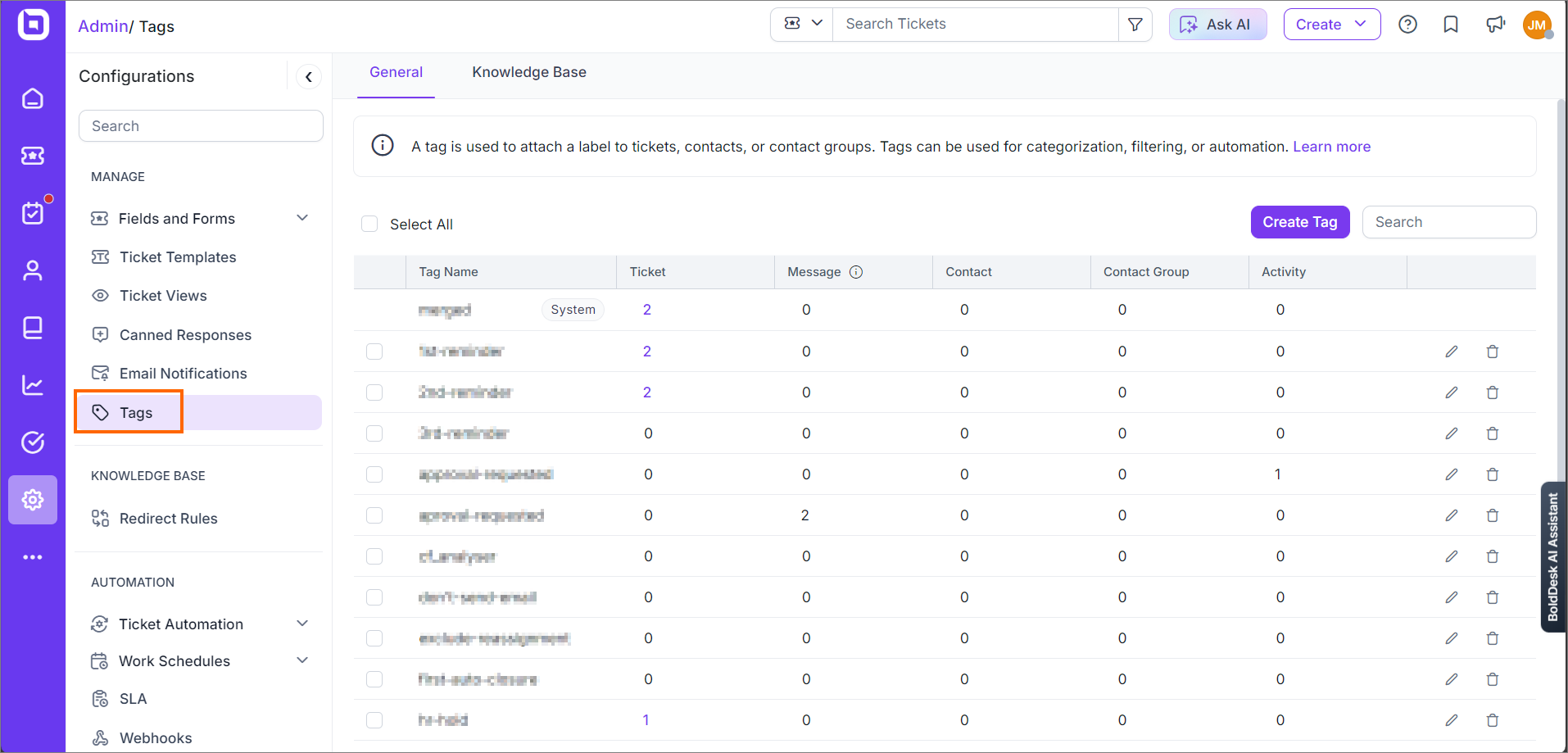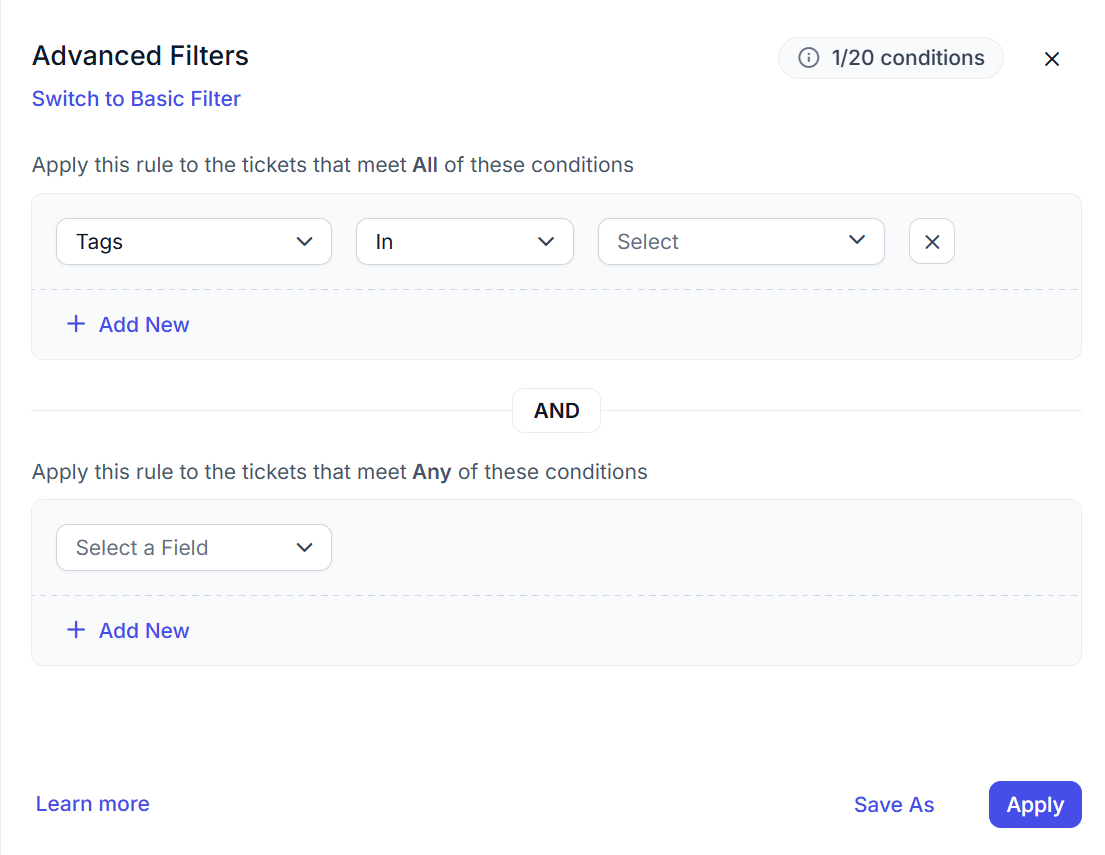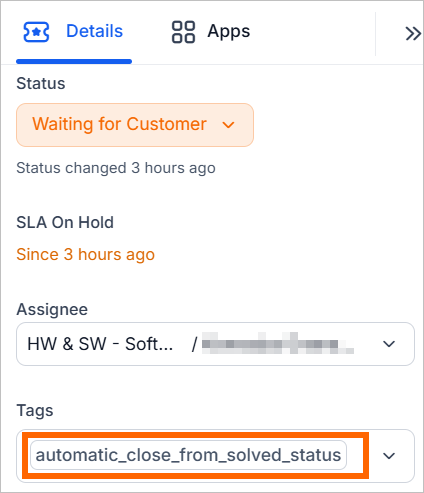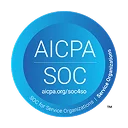For support agents, it can be quite challenging to manage many customer requests at once without a proper method to organize and prioritize them. They are likely to take up more time to provide responses to customer issues and assign the ticket to the right agent.
Implementing an effective ticket tagging solution in your help desk system ensures your support teams can easily search for, filter, prioritize, and categorize support requests.
Tags and tickets are the perfect combination for any business looking to optimize their ticket management, improve searchability, provide faster responses to clients, and encourage team collaboration.
In this article, we’ll define what ticket tagging is, its benefits, and best practices to improve your support operations.
What is ticket tagging?
Ticket tagging is the process of assigning labels or tags to support tickets to help categorize and organize them. Different businesses can tag tickets based on criteria such as type, priority level, department, or other relevant attributes.
Upon creation of a ticket, agents are able to manually select suitable tags which correspond with the request or the problem, and thus making it easier for them to assign it to the right expert for fast resolution.
Alternatively, ticket tagging can be automated based on specific conditions. Users can set help desk automation rules that trigger tags to be automatically added to tickets whenever the support request meets certain conditions.
For example, tags can automatically be added if certain keywords appear in the description or subject, or if any other conditions have been defined.
If a client mentions a description relating to a ‘technical issue’ within their request, a tag will be automatically added to help categorize, prioritize and route the ticket to the networking team.
Examples of ticket tags
Ticket tags can be classified according to urgency, type, or category of a support request. Setting up tags can assist your support team to search and easily find support tickets to direct them to the right expert.
Below are some of the common ticket tags used within various organizations:
- Technical issues – Related to any kind of technical problem or bugs.
- Escalation – Support issues that need to be transferred to a higher level of support or management.
- Customer feedback – Any reviews from clients, such as complaints, suggestions, or compliments.
- General inquiries – All other types of questions that do not fall under specific categories.
- Billing/payments – Questions about billing, invoices, or payment issues are covered here.
- Updates – Ongoing issue tickets and projects.
- Cybersecurity – Security related issues such as security breaches, phishing attacks, password changes, among others.
Streamline your HR Support Operations with BoldDesk
An all-in-one Help desk with a one-page ticketing interface to help you execute your support operations in a jiffy. Sounds interesting?
What information do tags communicate about a ticket?
Ticket tags convey different types of information that help support agents managing customer service problems as quickly and smoothly as possible. This includes:
Status updates
Tags provide information regarding the current resolution progress of the ticket. The ticket status can be categorized as new, open, solved, on hold, pending, or closed.
Status updates enhance transparency between customers and support agents since both parties are kept informed about the tickets’ progress and expected resolution time.
Product or service area
Some companies may offer more than one product or service. In such cases, it is beneficial to categorize tags to specify the product or service a particular ticket relates to. This would enable your support team to direct the ticket to the most qualified individual.
For instance, a ticket tag that indicates an issue is associated with a website, or mobile application may be sent to the IT customer support team for quick resolution.
Issue category
With a ticket tag, you can know the specific type of problem a customer is facing and organize incoming customer requests accordingly. In a help desk ticketing system, it provides information necessary for organizing all the tickets based on issue types.
Examples of these issue categories include login issues, technical problems, feature requests, or customer complaints.
Time frame
Ticket tags can include the priority level of a ticket that helps support teams know the specific time limit within which clients expect their issues to be addressed.
For instance, a ticket with a ‘critical’ priority tag can be set to have an SLA time of ‘1 hour’. This means the assigned support agent should aim to resolve it within the shortest time possible.
Addressing the urgent issues first ensures that you meet the set SLA time, keep the workflows organized and improve escalation management.
User categories
Businesses can add ticket tags to divide tasks according to the type of user or contact groups such as new client, VIP and organizations.
Organizing tickets based on the user category helps support teams provide a more personalized and prioritized assistance that will lead to higher client satisfaction and loyalty.
How to tag tickets effectively
Ticket tagging is a structured process within an organization that can help to improve the efficiency of your ticket management. Let’s look at the best practices for ticket tagging within your company.
Clearly defining categories
Provide categories for various types of tickets. This involves having guidelines on how categorization may be done and what each tag stands for.
Categories should not be complicated; they should be defined easily and kept consistent so that end users can correctly fill out the tickets.
Being uniform helps support agents easily understand and choose the right tags, hence minimizing confusion and delays in ticket processing.
Integrate your ticketing platform
With a ticketing system in place, businesses can automate the ticket tagging processes to easily categorize, prioritize and triage the incoming support requests to the appropriate user group.
This system allows agents and end-users to easily create, delete, and edit tags in tickets.
What’s more, support teams can set specific SLA triggers or conditions to automatically tag or label tickets. With these tags, they can keep track of the ticket progress, escalate the SLA-due tickets and so forth.
BoldDesk is one of the best comprehensive yet flexible ticketing systems worth considering, offering both manual and automated ticket tagging solutions to ensure fast searchability, issue tracking and resolution.

Set up a ticketing workflow hierarchy
Understand which department or contact groups should be managing what types of tickets, ensuring that each category has a clear path on how it will be resolved.
This helps to arrange tickets while focusing on the level of urgency, expertise required, and complexity of the matter.
Furthermore, allowing the tickets to be routed to the appropriate agent based on those tags.
Regularly review tags
As organizations evolve, so do their products, services, user groups, and workflows. This can make tags outdated or irrelevant.
Regular auditing of ticket tags keeps them relevant and useful by getting rid of the old and outdated tags that would be overflow the system.
Training your support agents
Offer training sessions to describe what each tag means, when to use it, and how it helps with the overall efficiency of ticket management.
Make sure your support agents understand how to correctly apply tags to maintain consistency across the board.
It might even be a good idea to have a feedback portal through which agents can give feedback or request the creation of new tags when needed.
Don’t over-tag
It is important to keep the tagging system simple for users. Adding too many tag options may confuse the users in deciding the right option.
Collaborating with product team managers and departmental heads can help to properly identify tags that are essential for effective categorization.
Benefits of ticket tagging
Ticket tagging helps with managing service requests and inquiries. The following are the major benefits of having a ticket-tagging system in your organization:
Improves searchability
Assigning specific keywords or tags to tickets makes it easier for the agents to search for, filter, and retrieve them almost instantly rather than sifting through irrelevant requests which can be very time consuming.

Reduces response times
Having clear and specific tags allows support teams to quickly understand the context of each ticket at first glance. This reduces the time spent analyzing individual tickets, allowing agents to give a quick response to customer inquiries.
In situations where similar issues may have been solved with the same tag, agents can use the past solutions to give speedy responses.
Helps streamline workflows
Ticket tags carry information such as issue type, user categories, urgency level, and time-frame. Knowing this information makes it easy to automate ticket routing and assignment of customer requests to the right agent, which streamlines the workflow.

When a ticket has multiple tags or labels of different categories, the respective user groups can also easily collaborate within a shared inbox on the labelled tickets.
Additionally, you can add tags to messages or conversations within a ticket to encourage cross-team collaboration and sharing of ideas, ensuring they resolve issues quickly.
Enhances customer service
Ticket tagging improves customer service by enabling the effective routing of tickets to the right teams or specialists who can handle them within the shortest time possible.
According to BusinessDasher, 77% of the clients believe that fast responses is the best service an organization can offer.
Automated ticket tagging using an email ticketing system makes it easier to triage, prioritize, and manage support issues for faster resolution.
Moreover, ticket tagging helps to reveal trends in customer service, which helps organizations to address persistent issues, and improve the services offered.
Provides quality analytics and reporting
Adding tags enables the classification of tickets based on factors such as type of issue, urgency and customer segment. These ticket categories help when compiling and analyzing reports to get valuable insights into the agents’ and ticket performances.
Simplify support with ticket tagging
Ticket tagging helps assign appropriate tags to different support requests, hence the agents can quickly understand the context of each ticket. This helps with improved response time, better organization, and customer satisfaction.
With BoldDesk ticketing system, you can easily create, edit, and delete ticket tags for effective ticket management and customer support.
Schedule a 30-minute live demo to see how ticket tagging in BoldDesk can help you save time and get organized. You can also take up a 15-day free trial to explore the features firsthand. For more information, contact the BoldDesk support team.
Do you have suggestions on how to better implement ticket tagging? Share your thoughts in the comment section below.
Related articles
- Best Automated Ticketing System for Businesses (2024)
- 7 Best Help Desk Workflow Automation Ideas
- Ticket Deflection: How to Reduce Support Tickets With Self-Service Solutions
FAQs
Why is automated ticket tagging superior to manual tagging?
With automation, much time is saved as it enables high volumes of support requests to be processed within a short period of time. In contrast with manual ticket tagging that requires customer care representatives to independently apply tags to tickets.
Automation reduces human error by making sure there is consistency across all the tickets, which enhances the accuracy of data collected and reporting capabilities.
Overcoming challenges in ticket tagging
Common problems faced in ticket tagging may include:
- Incorrect labeling
- Excessive use of tags
- Inconsistent tagging
To overcome these challenges, every organization should have clear guidelines for creating tags and maintaining them, and also effectively train their support team on the best strategies to use.
Ticket tagging use cases
- Customer segmentation – This assists support agents to organize requests based on the type of client.
- Priority tagging – Helps to show tickets that require urgent attention from customer care agents.
- Topic-based tagging– Refer to the practice of assigning tags depending on the nature of the request.


















 Email Ticketing System
Email Ticketing System Shared Inbox Software
Shared Inbox Software Multi Brand Help Desk
Multi Brand Help Desk Internal Help Desk Software
Internal Help Desk Software Trouble Ticketing Software
Trouble Ticketing Software Mobile Help Desk
Mobile Help Desk 


















